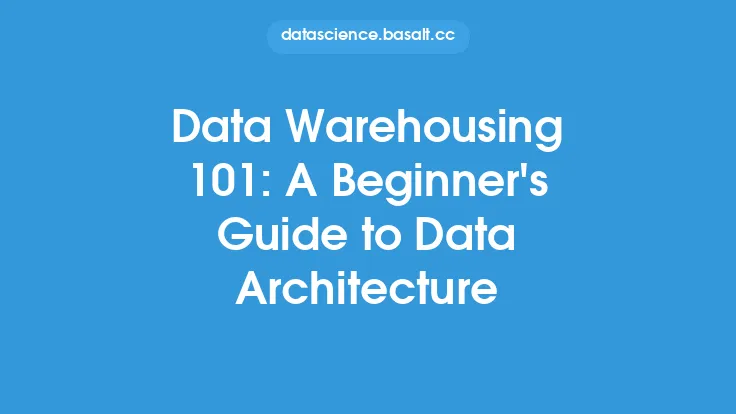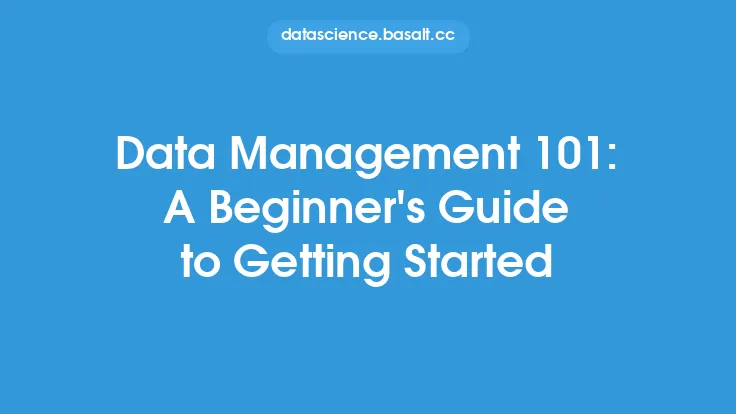Data lineage is a crucial aspect of data quality that involves tracking the origin, movement, and transformation of data throughout its entire lifecycle. It provides a clear understanding of where the data comes from, how it is processed, and how it is used, enabling organizations to make informed decisions and ensure the accuracy and reliability of their data. In this article, we will delve into the world of data lineage, exploring its definition, benefits, and key components, as well as the tools and techniques used to implement it.
What is Data Lineage?
Data lineage refers to the process of tracing the data's journey from its source to its final destination, capturing all the transformations, aggregations, and calculations that occur along the way. It involves creating a detailed map of the data's flow, including the systems, applications, and processes that handle the data. This map, also known as a data lineage graph, provides a visual representation of the data's lineage, making it easier to understand and analyze.
Benefits of Data Lineage
Data lineage offers numerous benefits to organizations, including improved data quality, increased transparency, and enhanced decision-making. By tracking the origin and movement of data, organizations can identify errors, inconsistencies, and biases, and take corrective action to ensure the accuracy and reliability of their data. Data lineage also enables organizations to comply with regulatory requirements, such as data privacy and governance regulations, by providing a clear audit trail of the data's journey.
Key Components of Data Lineage
Data lineage involves several key components, including data sources, data processing, data storage, and data consumption. Data sources refer to the original systems, applications, or processes that generate the data, such as databases, files, or user input. Data processing involves the transformations, aggregations, and calculations that occur as the data moves through the system, such as data cleansing, data integration, and data analytics. Data storage refers to the systems, applications, or processes that store the data, such as databases, data warehouses, or file systems. Data consumption refers to the final destination of the data, such as reports, dashboards, or user interfaces.
Data Lineage Tools and Techniques
Several tools and techniques are used to implement data lineage, including data cataloging, data mapping, and data tracking. Data cataloging involves creating a centralized repository of metadata that describes the data's structure, content, and context. Data mapping involves creating a visual representation of the data's flow, including the systems, applications, and processes that handle the data. Data tracking involves monitoring the data's movement and transformation in real-time, using techniques such as logging, auditing, and monitoring.
Data Lineage Metadata
Data lineage metadata refers to the information that describes the data's lineage, including the data's origin, movement, and transformation. This metadata can be captured at various levels, including the data element level, the data set level, and the data flow level. Data element level metadata describes the individual data elements, such as columns or fields, and their relationships to other data elements. Data set level metadata describes the collections of data elements, such as tables or files, and their relationships to other data sets. Data flow level metadata describes the movement of data between systems, applications, and processes, and the transformations that occur along the way.
Data Lineage Standards and Best Practices
Several standards and best practices have emerged to support the implementation of data lineage, including the Data Governance Institute's Data Governance Framework and the Data Management Association's Data Management Body of Knowledge. These standards and best practices provide guidelines for data lineage implementation, including data cataloging, data mapping, and data tracking. They also provide guidelines for data lineage metadata management, including data element level metadata, data set level metadata, and data flow level metadata.
Data Lineage Challenges and Limitations
Despite its benefits, data lineage implementation can be challenging, particularly in complex and distributed systems. One of the main challenges is capturing and managing the vast amounts of metadata required to support data lineage. Another challenge is integrating data lineage with existing data management systems and processes, such as data warehousing, data integration, and data analytics. Additionally, data lineage implementation can be limited by the availability and quality of metadata, as well as the complexity and scalability of the systems and processes involved.
Conclusion
Data lineage is a critical aspect of data quality that involves tracking the origin, movement, and transformation of data throughout its entire lifecycle. By providing a clear understanding of where the data comes from, how it is processed, and how it is used, data lineage enables organizations to make informed decisions and ensure the accuracy and reliability of their data. While data lineage implementation can be challenging, particularly in complex and distributed systems, the benefits of improved data quality, increased transparency, and enhanced decision-making make it a worthwhile investment for any organization.




